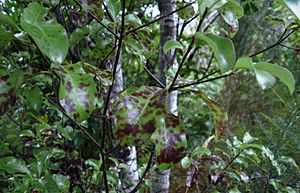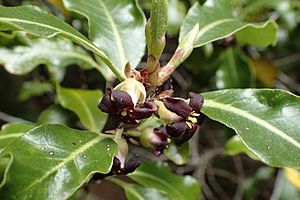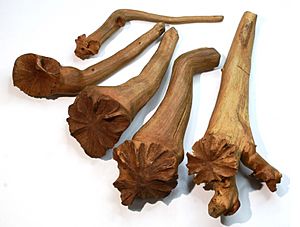Pittosporum tenuifolium facts for kids
Quick facts for kids Pittosporum tenuifolium |
|
|---|---|
 |
|
| Scientific classification | |
| Genus: |
Pittosporum
|
| Species: |
tenuifolium
|
Pittosporum tenuifolium is a small evergreen tree from New Zealand. It can grow up to 10 metres (about 33 feet) tall. People often call it kōhūhū or black matipo. It also has other Māori names like kohukohu and tawhiwhi. Its tiny, dark reddish-purple flowers are usually hard to spot. They only smell sweet at night. The name tenuifolium comes from Latin and means "slender-leaved," which describes its leaves.
Contents
What Kōhūhū Looks Like
The scientific name of kōhūhū helps us understand its features. Pittosporum means "tarry seed." This is because its seeds are covered in a sticky liquid. Tenuifolium means "thin leaf."
Kōhūhū grows as a bush or a small tree. It can reach about 8 to 10 metres (26 to 33 feet) tall. The trunk is thin, about 30–40 cm (12–16 inches) wide. Its bark is dark grey and mottled, meaning it has patches of different shades. The bark turns almost black towards the tips of the branches.
The leaves of kōhūhū grow close together. They are arranged one after another along the stem. The leaf stalks are short. The leaves are usually small, about 2–4 cm (0.8–1.6 inches) long and 1–2 cm (0.4–0.8 inches) wide. Some can grow up to 7 cm (2.8 inches) long. Their edges are wavy, and their shape can be oval or almost round. Young leaves have fine hairs, but these fall off as the leaves grow. Adult leaves are smooth and shiny. The leaves are a silvery green color, darker on top and lighter underneath. The main vein and smaller side veins are whitish and easy to see on the top of the leaf.
Kōhūhū has small, dark flowers, about 1 cm (0.4 inches) across. Their color can be dark red to dark purple. They turn almost black as they get older. Sometimes, they can even be red or yellow. The flowers grow from side buds, either alone or in small groups. They can be male or have both male and female parts (bisexual).
These flowers are full of nectar. They release a honey-like smell in the evenings, especially when it's a bit damp. This scent attracts moths and other night-flying insects. These insects are thought to help the plant make seeds.
After the flowers are pollinated, they turn into small, round fruits. These fruits are about 1.2 cm (0.5 inches) wide. When they are young, they have a few hairs. As they ripen, the hairs fall off. The fruit shrinks, gets hard, and turns almost black. When fully ripe, it splits into two or three parts. Inside, there are black seeds covered in a very sticky substance. This stickiness likely helps the seeds spread to new places.
Names for Kōhūhū
Here are some common names for this plant:
- Matipo
- Black matipo
- Rautawhiri Rautāwhiri
- Kairaro
- Kihihi
- Kowhiwhi, Kōwhiwhi
- Kohukohu
- Koihu
- Māpauriki
- Pōhiri
- Pōwhiri
- Tāwhiri
- Tawiri
- Tawhiwhi
- Silverleaf
- Turpentine-tree
- Black birch
Where Kōhūhū Grows
Global Range
Kōhūhū is a plant that grows only in New Zealand. This means it is endemic to New Zealand.
New Zealand Range
You can find kōhūhū all over New Zealand. It is not found only in the west of the Southern Alps and on Stewart Island.
Preferred Habitats
Kōhūhū grows naturally in forests near the coast and in lower mountain areas. It can be found up to 900 metres (about 2,950 feet) high.
It grows very fast at the edges of forests, especially at the bottom of high terraces. You can also find it growing in riverbeds. Kōhūhū grows easily in disturbed forest areas or on old farmland. It plays an important role in how new forests grow, a process called ecological succession.
Kōhūhū Life Cycle
Most plants in the Pittosporum family are easy to grow from seeds. However, the seeds can take a long time to sprout. When people grow kōhūhū in gardens, they often remove the sticky stuff from the seeds. This sticky coating actually stops the seeds from growing right away. To help the seeds sprout better, they are treated to act like they've been through natural conditions for six weeks.
Kōhūhū grows quite fast. It can grow from 0.5 metres to 3 metres (1.6 to 9.8 feet) tall in just five years. Its roots are shallow and spread out. Because of these features, kōhūhū is good for stopping soil erosion and stabilizing stream banks when planted with other plants.
Kōhūhū flowers in late spring, from October to November. Its fruits ripen between mid-summer and autumn, from January to March.
The young kōhūhū plants are a bit special. Sometimes, their first leaves (called seed leaves) have three or four instead of the usual two.
Where Kōhūhū Grows Best
Kōhūhū is a tough plant. It can handle difficult conditions like poor soil, dry weather, and windy places. However, it needs a lot of light. It prefers soils that drain well and humid climates. If it's planted in very damp conditions, it might lose its leaves in winter. This could be why kōhūhū is not found on the West Coast of New Zealand. Kōhūhū often grows in less fertile soils than its relative, lemonwood. It usually appears earlier in the process of ecological succession.
Pests and Diseases
Insects
More than 50 types of insects are known to feed on or live on kōhūhū. These include wasps, sucking bugs, flies, moths, butterflies, thrips, mites, and beetles. There are also over a dozen types of beetles that eat dead kōhūhū plant material.
Here are some interesting insect species:
The Pittosporum flower weevil (Aneuma rubricale) is a native insect. It lays its eggs only on kōhūhū flowers, even though the adult weevil eats other Pittosporum plants. When the weevil larvae hatch, they eat the flower parts. As adults, they switch to eating the leaves.
The Pittosporum shield bug (Monteithiella humeralis) came from Australia. The native Pittosporum psyllid (Trioza vitreoradiata) also feeds only on Pittosporum species. They attach themselves to the plant and suck its sap. The psyllid leaves a trail of small, bead-like drops.
Other bugs like the Cottony cushion scale (Icerya purchase), soft wax scale (Ceroplastes destructor), and the Australian green shield bug (Glaucias amyoti) also feed on Pittosporum plants. These bugs also suck sap from the plant, but they can feed on many other types of plants too.
The New Zealand flower thrips (Thrips obscuratus) feeds on kōhūhū leaves, flowers, and young fruit. It does this by piercing the plant cells and sucking out their contents.
Fungi
A fungus called Pythium irregulare can cause problems for kōhūhū. It can cause the leaves to wither, rot, and eventually kill the plant.
Another fungus, Elsinoe takoropuku, was recently found on kōhūhū. It causes the twigs to swell. This fungus was a new discovery and has only been found on kōhūhū so far.
Uses of Kōhūhū
Garden Plant
Kōhūhū is a popular plant for gardens in New Zealand and other countries. People often use it as a hedge or as a green background plant. Sometimes, it's grown under the name 'Nigricans' because of its black stems. Gardeners like it for its colorful leaves, which can be purple, "silver," or have mixed colors. It's also valued because it can grow in tough conditions, like dry soil and shade. However, it doesn't do well in very cold or exposed places in northwest Europe.
Several new types of kōhūhū, called cultivars, have been created. Five of these have won an award from the Royal Horticultural Society. This award means they grow well in the United Kingdom.
- 'Arundel Green'
- 'Garnettii'
- 'Irene Paterson'
- 'Silver Queen'
- 'Tom Thumb'
- 'Warnham Gold'
Helping the Wood Rose Plant
Kōhūhū can be used to help a special plant called the wood rose (Dactylanthus taylorii). The wood rose is a rare plant that lives as a parasite on the roots of other plants. Scientists recently moved wood rose plants and seeds to new wild areas. They found that the wood rose grew best when planted with kōhūhū.
Used by Māori People
The Māori people have used kōhūhū in many ways. They used the resin and oils from the leaves for their scent. These were often mixed with parts from other native trees to make different kinds of scented oils. The resin was collected by making cuts in the tree's bark. The leaves were crushed and mixed with other oils. This scented oil was used to make small pouches or to scent the skin of dead birds, which people wore around their necks. The oil was also used to make the homes and mats of important people smell nice.
Kōhūhū was also used by Māori for medicine. The resin was mixed with other plant gums and chewed to help with bad breath and mouth sores. Parts of the plant were used on the skin to treat skin diseases. Crushed leaves were made into a poultice (a soft, moist mass) to put on ulcers. Crushed bark was soaked in water, and the liquid was used to treat chest problems. This liquid could also be drunk. It was also used with flax roots to make a drink for fevers, bleeding, and bruising. A study in 2010 showed that kōhūhū does have properties that can fight germs, which supports its traditional use as a medicine.
Finally, kōhūhū branches were used in important Māori ceremonies, like baptisms. They are still used today for welcoming visitors to a marae (a Māori meeting place). Two of its common names, tāwhiri ("to wave to") and rautāwhiri ("to wave a leaf"), show this use.
See also
 In Spanish: Pitosporo de hojas tenues para niños
In Spanish: Pitosporo de hojas tenues para niños




